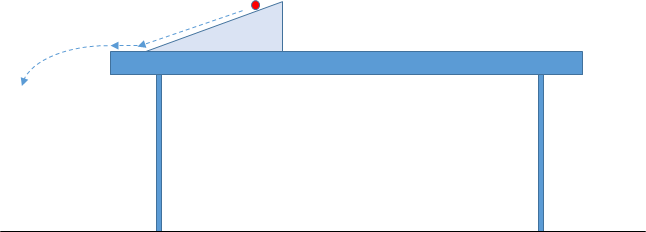Apparatus:
- ramp (make your own from a book, a
board, or something similar; the thinner the better, but be sure
that it is straight, not bowed. A ruler with a groove in the
middle might be ideal.)
- marble
- ruler
- stopwatch (use a timer on your phone or on the computer)
Procedure:
You are going to use a ramp to give a marble a reproducible speed, and shoot
it off the edge of a table. You will first measure the initial speed at which it
leaves the table, then you predict and measure where the marble will hit the
floor for a different table height. When you shoot your projectile, you are going to want to make it as reproducible as
possible. You need to make sure that you carefully mark the height of your
ramp, the position of your ramp on the table, and where you start the marble on
the ramp.
A. Determination of the Initial Speed of the Projectile
- Setup your ramp near (but not right at) the edge of a table. Set the ramp
at not too great an angle, as shown, and be sure to mark locations so that
it is reproducible.

- Get a little practice launching the projectile. Roll it off the
table from the same place on the ramp, see how reproducible you can make it,
then tape some paper to the floor so that the marble will hit the paper. If
you have access to carbon paper, lay it on top of the paper so when the marble
hits, it automatically makes a mark (we will provide carbon paper starting in
2023, sorry 2022!)
- Now you are ready to take data. Launch the projectile a minimum of 5
times, carefully marking where it hits the paper each time. (This part might
benefit from a partner to help if you do not have carbon paper.)
- Use the height of the edge of the table from the floor, the horizontal
distance that the marble travels from the edge of the table to where it
first hits the floor, and kinematic relationships to determine the speed at
which the marble leaves the table (the "initial velocity").
- Calculate the initial
average speed to 90% confidence.
B. Determination of the Range of the Projectile
Now we want to change the height of the launch from the
floor - find a different height table, or put your launch apparatus on a
stack of books or a box. Be sure to use the same setup: distance of ramp
from edge of table, angle of ramp, starting position of marble on ramp.
Predict
the horizontal distance that the projectile will travel before hitting the
ground. To predict this, we need to use kinematics, or the
derived range equation from the
theory section:
 .
.
Mark on the ground where you predict the projectile will land.
- Now launch the marble from the new height and measure the range.
Do this at least 5 times. Mark where the projectile actually lands. Take a
picture of the predicted vs. actual landing spots for your lab notebook!

Department
of Physics



 .
.
